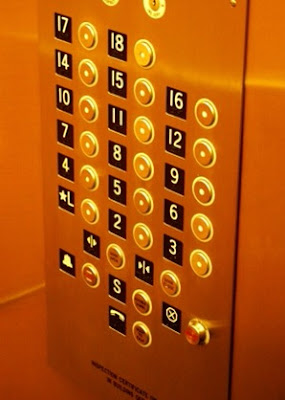Thirteenth Floor is the name of a multi-storey building that is often abandoned in countries where the number 13 is considered lucky. Crossing the 13th floor can take a variety of forms; the most common ones include showing what might be considered a thirteenth floor as level 14, giving the thirteenth floor another word "12A" or "M" (thirteenth letter of the Latin list), or closing the 13th floor in public to sit or enter ( e.g., by setting it as a place to do things).
Reasons for leaving the thirteenth floor include triskaidekaphobia which is the property owner or builder, or the desire of the property owner or landlord to prevent potential problems with superstitious tenants, residents or customers. In 2002, based on internal records reviews, Dilip Rangnekar of Otis Elevators estimated that 85% of buildings with Otis product elevators do not have a space called 13th floor. The founders of tall buildings, fearing fire on the 13th floor, or fearing the superstitions of tenants about the rumors, have decided to stop having the 13th floor listed in their elevator list. This practice became commonplace, and eventually found its way into the common American culture and architecture.
Vancouver city planners have banned the practice of skipping 4 and 13, as it can lead to errors by first responders, for example going to the wrong floor.
Origin
The background of skipping the thirteenth floor when you enter the known elevators. However, at the time of the arrival of the first buildings, critics of New York buildings warned developers not to exceed the 13-story height. These critics have stressed that buildings that rise above the 13th floor (130 meters or 40 meters) will lead to an increase in traffic congestion, horrible shadows and low property prices. However, in a work published in 1939, sociologist Otto Neurath compared economic expenditure, which he saw as unnecessary, and the superstition of not including the thirteenth floor: just a social gathering.
Ways
Skipped
Generally, 13 is skipped, as in: 12, 14, 15 ... The floor marked "14" in the elevator is thirteenth floor and the number 13 is skipped on the cash console.
12A, 12B, 14A, and 14B
In some cases the retention of numbers on the 13th floor is simply re-numbered as 12A or 12B, as in: 12, 12A, 14 .., or 12, 12B, 14; this does not affect the numbers of the upper floors. Similarly, 14 can be used on the 13th floor and 14A or 14B can be used on the 14th floor.
Special positions
Some buildings often use the names of certain floors to avoid giving the building space a 13-point building. One such example is the Radisson Hotel in Winnipeg, Manitoba, where the 13th floor is called the pool floor. Another example is the Sheraton Falls in Niagara Falls, Ontario, where the 13th floor has only a restaurant. A third example is the Trump International Hotel and Tower Chicago in Chicago, Illinois, where the 13th floor is a mezanine floor.
No one lives on the 13th floor
In some cases, the floor is put in a separate container, such as a refrigerator for use. Such use is sometimes the subject of conspiracy theories (see below).
Book M
Because the letter M is the 13th letter of the Latin alphabet, some people may use the letter M instead of the 13-digit position, such as 12, M, 14, and so on. In Richmond, Virginia, the Monroe Park Towers have 13 floors, but they are used for equipment and are only available in cargo cash or on stairs. The designation of the M in the cash register of the inventory of the goods can also be defined as Mechanical level in this particular building, or as the standard Mezzanine.
Split-level apartments
In some cases, the tenement block will consist of separate floor apartments where the units themselves contain internal stairs and large building elevators and therefore do not stand on all floors. One example is Princess Towers in Kingston, Ontario, with 16 + 1⁄2 news outside the roof. The lifts are limited to B (lower), G (lower), 3, 6, 9, 12 and 15th floor only. In this case, the unmarked 11th and 13th flats are located within the 12th floor units marked.
Research
In the 2007 Gallup poll, 13 percent of American adults reported that they would be concerned if they were not offered a hotel room on the 13th floor, and 9 percent indicated that they would not be worried enough to request a separate room. A study of the effects of the thirteenth floor on property prices presents a mixed picture. Many prominent American real estate agents say they know nothing about the reduction in the number of thirteen-storey offices or apartments. On the other hand, in a study conducted in Russia, Burakov found that thirteenth-floor apartments were less likely to be sold than those in the twelfth or fourteenth-floor apartments. This result, however, was removed when engineers promised buyers a 10% or more discount on the cost of 13th floor apartments.
The opposite
Topic: Tetraphobia
Similarly, new buildings in some parts of China avoid the fourth, fourteenth, twenty-four floors, etc., as the word "four" (Hanzi: 四) sounds like "death" (死 - pronounced "sì" and "sǐ", respectively. ) in Mandarin, the world's predominant language, and many other Chinese. A small number of buildings also follow the American tradition of abandoning the thirteenth floor, the fifteenth floor immediately following the twelfth. Another variation found in Vietnam is designing stairs 13 and 14 as under “12A” and “12B” respectively.
In South Korea, buildings usually occupy the fourth floor without the same pronunciation problems in the Korean language, or other new structures can replace the letter F instead of the number 4.
Room thirteen
In some buildings, 13 is also skipped as a room number. A 13-room apartment (since 1946) Boots Court Motel in the U.S. Route 66 is one example; its chambers are numbered 1, 2, 3, 4, 5, 6, 7, 8, 9, 10, 11, 12 and 14.
Writer : Taseer Abbas








0 Comments